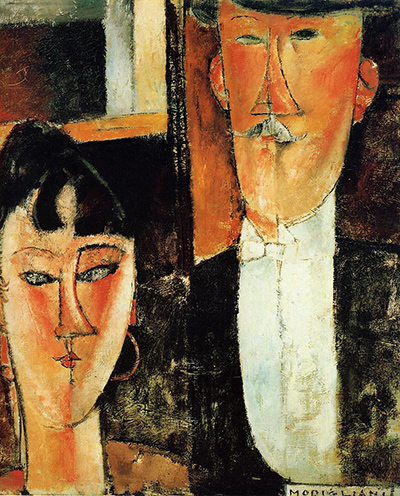Amedeo Modigliani's painting Bride and Groom (1915) goes by some other names, including "The Newlyweds" and "The Couple". It is an oil on canvas painting currently held in The Museum of Modern Art in New York City, USA.
This painting displays some of Modigliani's most prominent characteristics. Modigliani's body of work has many portraits of individuals and pairs of people, in this case a newly married couple.
This is supported by the gentleman's fancy dress. While the women's clothing cannot be seen, it can be imaged her dress would match the level of the groom's. The elongated faces and necks of the subjects are also typical of Modigliani's style.
Their minuscule mouths, pointed noses and empty eyes are also a common style in Modigliani's portraits, undoubtedly inspired by his fascination with African masks and sculpture. The woman in the painting also represent's Modigliani's aesthetic ideal: dark hair and pale skin.
This painting is often compared to Modigliani's later painting, Jacques and Berthe Lipchitz (1916) because they are both of couples. However, Bride and Groom is considered to be much more cartoon-like than the other painting in which the subjects look like actual humans.
Art historians believe this shows a major development in Modigliani's drawing and painting style over just one year. Bride and Groom is considered to depict types of characters while the later painting shows refinement and a greater focus on individuals.
This does not necessarily downplay the artistry behind Bride and Groom as it is still an interesting and beautiful painting in it's own right.
The actual subjects of the painting are unknown but they were most likely acquaintances of Modigliani's as they were often the subjects of his paintings and portraits. Perhaps this is an earlier version of Jacques and Berthe Lipchitz as it clearly resembles the later painting of the couple.
It is also possible it is a random couple as Modigliani likely met various people during his interesting life in Paris and could have easily asked a newlywed couple to sit for one of his many portraits. Both of these paintings make up the only two paintings of couples in Modigliani's vast body of work that still exist today.




